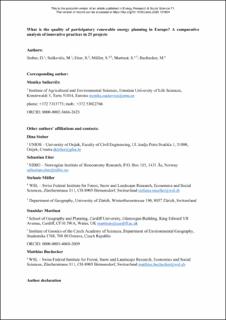| dc.contributor.author | Stober, Dina | |
| dc.contributor.author | Suškevičs, Monika | |
| dc.contributor.author | Eiter, Sebastian | |
| dc.contributor.author | Müller, Stefanie | |
| dc.contributor.author | Martinat, Stanislav | |
| dc.contributor.author | Buchecker, Matthias | |
| dc.date.accessioned | 2021-06-21T08:38:30Z | |
| dc.date.available | 2021-06-21T08:38:30Z | |
| dc.date.created | 2020-10-12T10:25:19Z | |
| dc.date.issued | 2021-01 | |
| dc.identifier.citation | Energy Research & Social Science. 2021, 71 . | en_US |
| dc.identifier.issn | 2214-6296 | |
| dc.identifier.uri | https://hdl.handle.net/11250/2760325 | |
| dc.description.abstract | There is widespread agreement that society must urgently go over to renewable energy and that effective participation is crucial for a sustainable transition. Recent literature highlights that the quality of participatory planning is decisive for the acceptance of renewable energy technologies. However, social science research on the issue is dominated by single case studies and the quality of the participatory processes has been rarely studied across wider regional contexts. We present the results of a comparative qualitative inventory of innovative practices from 25 projects in 12 countries in three supra-national European regions. We assessed participation quality according to three analytical dimensions: rationale, inclusiveness, and participation level. An instrumental rationale, broad inclusiveness, and a participation level of consulting or informing was a combination that was commonly perceived as an innovative participatory practice in most regional contexts. We found a tendency towards more advanced practices in Western Europe, compared to Southern, and Eastern Europe. However, practices that were considered to be innovative in the latter regions still provide important lessons within their geographical contexts. | en_US |
| dc.language.iso | eng | en_US |
| dc.publisher | Elsevier Ltd. | en_US |
| dc.title | What is the quality of participatory renewable energy planning in Europe? A comparative analysis of innovative practices in 25 projects | en_US |
| dc.type | Peer reviewed | en_US |
| dc.type | Journal article | en_US |
| dc.description.version | acceptedVersion | en_US |
| dc.rights.holder | © 2020 Elsevier Ltd. All rights reserved. | en_US |
| dc.source.pagenumber | 13 | en_US |
| dc.source.volume | 71 | en_US |
| dc.source.journal | Energy Research & Social Science | en_US |
| dc.identifier.doi | 10.1016/j.erss.2020.101804 | |
| dc.identifier.cristin | 1838804 | |
| dc.relation.project | COST (European Cooperation in Science and Technology): TU1401 | en_US |
| dc.relation.project | Norges forskningsråd: 194051 | en_US |
| dc.source.articlenumber | 101804 | en_US |
| cristin.ispublished | true | |
| cristin.fulltext | postprint | |
| cristin.qualitycode | 1 | |
